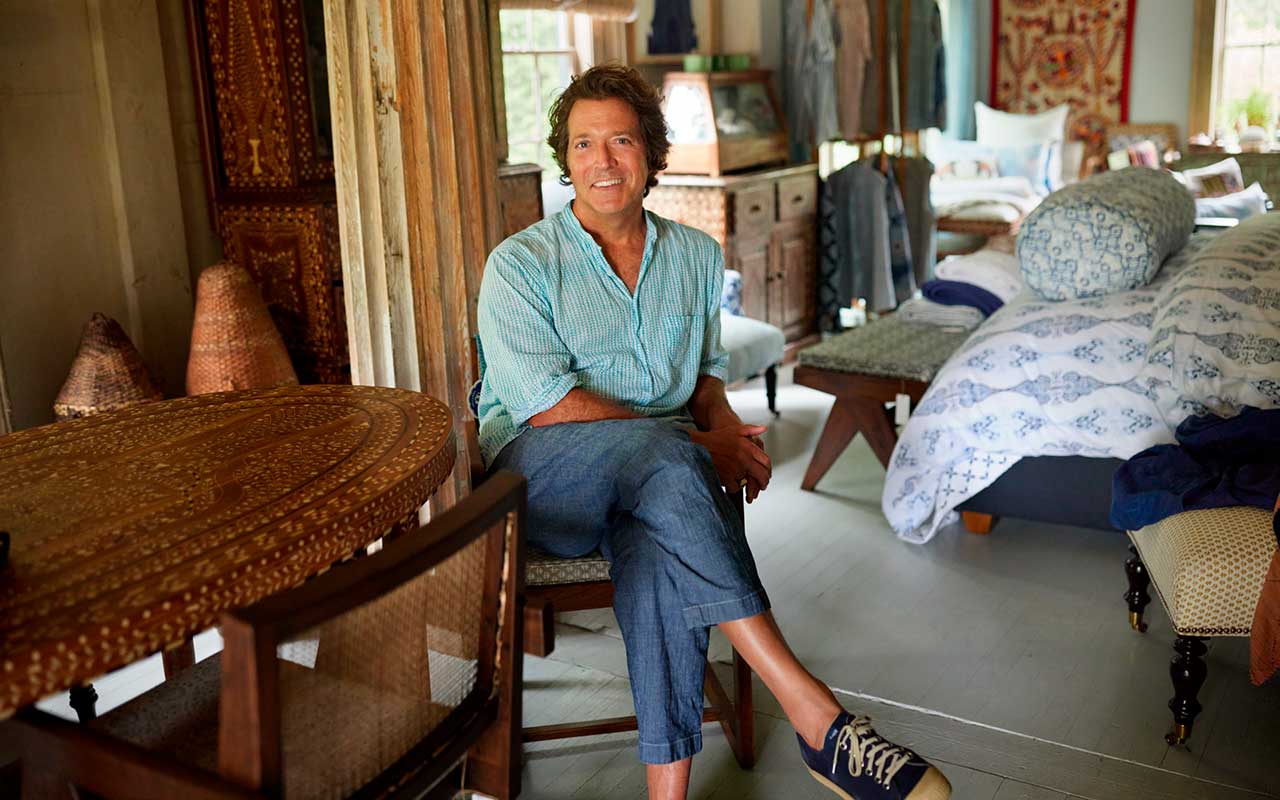Main Street Business

A Passage to India – John Robshaw, Textile Designer
The elephant on John Robshaw Textiles’ sign in front of the moody, gray house in Falls Village, CT, subtly suggests what awaits the visitor to the shop. Inside are the Indian-inspired block-print textiles that have created John Robshaw’s international design reputation – pillows, duvets, blankets, and sheets of cavorting elephants, tropical blossoms, trees, and south Asian patterns swirled together in sophisticated colors. Every corner of the store has an unexpected find – an indigo-dyed rug, mirrors, fruit trays, stone doves, art, inlaid tables, and clothes all sourced directly from India by Robshaw.
How and where it all began
As the Falls Village shop opened for business on a Friday morning, Robshaw recounted how he quite accidentally started a successful design business. After college, Robshaw studied painting at Pratt Institute in New York City. After receiving a master’s degree, he joined a group of other painters in a large cooperative studio space while working as an art handler for Larry Gagosian’s art gallery. Another part-time gig was traveling for New York designers like Ralph Lauren, who sent clothes to India to be hand sequined. Robshaw would spend several weeks in India traveling to Ahmedabad, Delhi, Jaipur, and Mumbai while waiting for the expensive dresses to be completed.
Robshaw had studied Chinese block printing while visiting China and wanted to learn about the Indian printing tradition. While hanging out at the Ahmedabad National Institute of Design he met some students who offered to introduce him to a master block printer in exchange for getting them a liquor license. This led him to Jaipur where he experimented with block printing textiles for fun, changing colors and mixing motifs. In addition to the $10,000 dresses, he returned to New York with samples of his fabric design. (His father advised him to make sure he wasn’t carrying drugs.) Interior designers visiting the painting studio started buying the fabric, and a business was born.
A happier life
Robshaw discovered that he could manufacture and import products and that fabrics were easier to sell than his decorative paintings. “I wanted a lifestyle business I could run and have a life.” To Robshaw the world of interior design seemed a happier place than the art scene. “It was more of a natural fit for me. You were not making this precious thing. You could sleep under it.”
Next, he heard about a trade show at the Javits Center. He covered his booth with colorful fabric and got a few small wholesale orders for his distinctive line. “Since I didn’t have any money, I made small mistakes and never got buried in inventory. The trajectory was slow, unlike in the fashion world.”
Pivoting amidst change
Robshaw observed that every business is unique. In the design world, interest in your product comes before profitability. Twice a year his studio introduces 50 new prints. The textiles are sold wholesale to the trade, online, and in his retail store in Falls Village. During COVID he decided to downsize from his expensive $20,000 a month New York showroom and focus on the Atlanta Mart show – the twice a year trade show for home textiles, where he wholesales to specialty and department stores. He now has a small working NYC studio staffed by junior designers and sales people. His only retail store is in Falls Village near his home base in Sharon. “I wanted to be in a destination spot with Bunny Williams, and the Town of Canaan gave me zoning permission to open a store. I’m happy with the retail store volume, which ebbs and flows. There are lots of decorators up here and no other linen store around.”
In back of the store is a large warehouse filled with Indian-made furniture with a Raj deco feeling and other interesting pieces that have caught Robshaw’s roving eye. Robshaw estimated that half of his revenue is from trade shows and travelling reps and half from direct customers.
There are some challenges …
Operations for his import business are centered in a warehouse in New Jersey with agents in India. “An excellent agent in India introduces you to good factories and knows who is making what where. For example, through my agent I was introduced to Garnett Hill, and we did a licensing arrangement. Quality control can be an issue in the home world, but especially in India with its monsoon season. If fabric is not quite dry when it gets packed, it arrives all weird and smelly.”
Dealing with department stores has become even more difficult for small businesses in what Robshaw described as pretty intense negotiations. “Another factor in the market is Internet/Instagram-focused design businesses like Serena & Lily, Brook Linens and Parachute, who are burning through money to get customers. It’s the biggest change in the home market. I can’t compete with businesses who have investors’ money. I own 100% of my company.”
Over the years Robshaw has been approached about selling his company. “I’m not interested in selling. I don’t care about owning a Ferrari – that’s not my goal. My wife and I have a three-year-old daughter and a good life-work balance. We play tennis on the Hotchkiss courts and go kayaking in the Housatonic. We enjoy low-key entertaining.”
His key to success
Asked why he has been successful, Robshaw feels that coming from art school gave him a different angle. He looked at prints in a different way. Over time, his collection has evolved as he listens to the market and his sales people. “I have learned what will work, but you must remain true to your core framework. You can’t be minimalist one season and change the next.”
Robshaw believes that building organically and dealing with all aspects of the business are also key. “When young people come to me and ask for advice, I always tell them to work in a showroom, be a salesman, learn the business you want to be in. I was also very fortunate to listen to my father and hire a CFO/CPA to help me on the finance side early on.”
“After 15 years, my CFO just retired. He came from the fashion world, which is pretty brutal, and prevented me from making big mistakes. My CFO always gave me a hard time, but he’d been through the wars and seen companies go under. He helped guide the growth of the business and watched inventory levels, cash flow, and accounts receivable. I learned that margins are sacred, and that excess inventory can kill you. I’ve seen textile companies with $20 to $30 million businesses fail.”
Always tempted by other south Asian cultures, Robshaw admires Jim Thompson’s textiles from Bangkok and the work of Carol Cassidy, who restarted the art of traditional Lao textile silk weaving in Vientiane, Laos. Like Cassidy, Robshaw has volunteered internationally to assist local artisans to create products for the American market. In 2012 he published a book, John Robshaw Prints: Textiles, Block Printing, Global Inspiration and Interiors, explaining his creative process and techniques. His very personal website joshnrobshaw.com showcases his products and also includes his adventures from the Maldives to Nantucket. •
To learn more about John Robshaw, please visit his website at johnrobshaw.com or his store at 5 US-7, Falls Village, CT.



